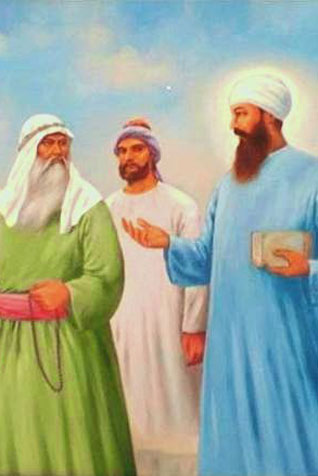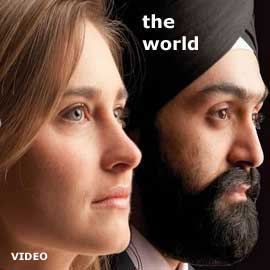Faith
Who Needs Miracles?
AJITPAL SINGH
As adults, we have the maturity and resources to educate ourselves about Sikhi and develop informed opinions based on our research.
But what about our kids?
They are too young to do it themselves – partially because their minds haven’t developed enough to absorb such complex concepts, and partially because they are distracted by myriad other things the world has to offer them. In such a situation, the onus is upon us to get them started on the right foot.
There are many ways to achieve this.
The oft used method is reading to them stories or sakhis from our Gurus’ lives - as these tend to hold their attention far better than long, abstruse lectures on gurbani or ritual recitation of paatths.
But in our zeal to encourage and inspire them, we sometimes tend to cross the line. We embellish the stories with elements of folklore and add our own little touches here and there. It is very important to pay due attention to the message being passed at such times.
In no time, our kids will grow up and start thinking about the examples we gave them. They will analyze and tear them apart based on principles of logic and rationale they would be fast developing. If some of our stories do not live up to their touchstone, they will be discarded and, worse still, they will completely sideline the countless others in the same vein.
The best way to avoid this, as well as ingrain the message in their young minds, is to focus on the moral of the story, rather than the dramatic elements.
For instance, we all know that Guru Nanak travelled all the way to Mecca during one of his Udasis to spread the true message of God. On one occasion, he was reprimanded by one of the qazis for pointing his feet towards the Kaaba. In response, th sleeping Guru requested the Qazi to move his feet so that they pointed in any direction where God wasn’t present.
We all know the qazi couldn’t do it. But is it really important to dwell on the fact- that the Kaaba actually moved each time to the direction his feet were moved?
Surely that is not the message Guru Nanak or the sakhi wished to convey. What is important, is the moral of the story - the qazi could not point the Guru’s feet in any direction where God was absent, as He is omniscient.
If our child gets this message, our time was worth it.
Is it more important to stress on the milk and blood aspect of the story about Guru Nanak’s audience with Bhai Laalo and Malik Bhaago? Or is it important to teach our kids that Guru Nanak chose to partake in the simple fare at an honest man’s hut instead of the vast spread at a dishonest, rich man’s palace.
Surely Guru Nanak did not intend to portray himself as a karaamati baba to his followers; even he would have wanted the actual message to be imbibed instead.
Did Guru Gobind Singh actually behead and bring back to life the Punj Pyarey on that glorious Vaisakhi day in 1699? Did he use the blood of a goat instead to fool the audience? Did he even use blood at all? I have seen many an adult belabour pointlessly about this for hours
But my question is - Does it really matter?
The fact is – the Guru asked for the heads of his loyal followers and one by one, the Punj Pyarey came forward – undeterred by the risk and danger. They were not scared even in the face of death. They did not care about their own lives, their families and other worldly attachments. When it came to answer the call of their Guru, they answered it in body and spirit. In doing so, they truly understood the message of Guru Nanak, centuries after it was uttered -
jau tau prem khelan ka chao / sir dhar tali gali mori aao
“If you wish to play the game of love, come to me with your head on the palm of your hand.”
Surely we couldn’t have had a better start to the Khalsa. Surely that’s the message to uphold in the face of worldly adversities. That is the message one should get from the incident, rather than arguing about the nitty-gritty of the actual goings on.
When mentioning these stories to your kids, which aspect of these do you think will stick with them as they grow up? The actual miracles within the story or the message they espouse?
Sikh history is replete with such incidents, each one giving us a lesson more valuable than the one before – all we need is to pass this glorious history to our next generation by presenting it in the right context.
Where else can they learn selfless service to society as with Guru Harkishan; sacrificing your life for truth and justice as with Guru Tegh Bahadar; or the unparalleled valour as with Guru Hargobind? Where can they learn that even as kids – be it Gobind Rai at the tender age of nine or, later, his younger sahibzaadey of an even more tender age – you can be more enlightened than adults who are far older and more experienced than you?
Our kids might also be exposed to other religious texts as they grow up. They may encounter other myths and legends. They may encounter fantastical myths - including the Ramayan and the Mahabharat – via television, books or the internet.
Do not discourage them to explore these. Rather, give them the gift of an analytical thought process - so they can sift through the dramatic elements, and ultimately absorb the core message, which is the same across all religions, for the most part.
With the changing times and circumstances, Sikhism (and other religions) will constantly face new questions and challenges. As our kids grow up in this new world, they will constantly face struggles of identity and existence.
During such times, only a deep understanding about one’s beliefs, values and culture and the logic behind them will be able to hold their interest. And that realization will come, only if we openly discuss and debate on such matters with them and teach them to think for themselves.
Lest we bind them to rigid doctrines and risk losing them ..
July 30, 2014
Conversation about this article
1: S. Kaur (Canada), July 31, 2014, 12:31 PM.
Although you may not wish to dwell on the fact that the Kaaba moved with Guru Nanak's feet, this detail isn't a later innovation but an actual part of Bhai Gurdas' vaar. We don't need to be ashamed of or avoid our own history even when it contains miracles or examples of God's infinite power.
2: AJ Singh (San Francisco, California, USA), July 31, 2014, 2:43 PM.
Excellent article. Even adults should be vary about believing in miracles and apply critical thought in understanding Sikh history and Gurbani. Regarding the Mecca incident, is Bhai Gurdas really saying that Mecca moved in the direction of the Guru's feet, or is he saying that as the Qazi moved Guru Nanak's feet, he realized that Mecca is everywhere. What does our critical thinking say?
3: Harbir Kaur (Kansas, USA), July 31, 2014, 3:27 PM.
Bhai Gurdas was a mystic and a poet. Poets employ metaphors to describe the indescribable. Mataphors are not meant to be taken literally, because they are far bigger and contain much more than what meets the eye ...
4: Ajitpal Singh (Virginia, USA), July 31, 2014, 5:24 PM.
I would just like to add that I do not wish to offend those who believe in the sakhis verbatim. It is a matter of faith and there is no way of proving or disproving them. The point I am making is merely the fact that the message conveyed through the incident should take precedence over the actual occurrence itself. Else it will remain limited to Sikh folklore or get lost amongst the countless others from other religions all over the world and the essence will be lost.
5: DJ Singh (USA), July 31, 2014, 11:11 PM.
Scientific knowledge is limited to the data received through the sense organs. A miracle is by definition an event that is as unlikely as anything else. Thirty years ago, the internet, wireless communication, remote access to your house and car would have been considered illusionary tricks or a miracle. Today, they are well accepted scientific marvels. Religion goes beyond the logic trapped within the limitation of relative perception. Should we just discard religious beliefs due to the current lack of rational explanation for events that happened in the past? "Pingal parbat par pare khal chuttar bakita" Take this literally or as a miracle! Either way you will be the winner! Religious scripture is the work of the Master(s). The interpretation of their message is based on our education and values. Scriptural accounts of miracles are often presented as persuasive evidence of the existence of God and Her intervention in human affairs. Such accounts are common to most religions. Miracles are simply events that point us towards God. Who needs a miracle? We all do! "Chirian te mein baaz tudaun / gidraan to mein sher banaun / sava lakh se ek ladaa-oon."
6: Ajitpal Singh (Virginia, USA), August 01, 2014, 11:01 AM.
DJ Singh ji: If I were to just comment on the concluding statement of your comment - "Chirian te mein baaz tudaun / gidraan to mein sher banaun / sava lakh se ek ladaa-oon." Do you think that happened just by virtue of the fact that Sikhs took Amrit from Guru Gobind Singh or Punj Pyarey? Or do you think Guru Gobind Singh meant that he intends to fashion the ideal Sikh through rigorous spiritual and physical training, one who will always fight for justice and who will always be in high spirits because their cause is just? This would have been followed (or preceded) by years of regimen and meditation and single minded devotion on the part of the Guru and his Sikhs. Countless sacrifices would have been made on the way. Either way, most significantly, it was the end result that was the miracle ... but what was the path or the message to be conveyed from the couplet ultimately? If a Sikh thinks today that just the act of partaking in Amrit makes him invincible, without following the underlying path and it's meaning, he would be sorely mistaken. The act is definitely a good and formal start, the actions that follow reflect the true power of Amrit, in my opinion.
7: D J Singh (USA), August 02, 2014, 11:00 AM.
Five ordinary men answered the Guru's call and offered their heads. This was a leap of faith. They then partook the Amrit. They made a promise to lead a pure and pious life. The transformation was thus instantaneous and complete. Faith, commitment and God's grace are the three elements associated with this ceremony.
8: Yuktanand Singh (Michigan, USA), August 02, 2014, 3:35 PM.
First, we need to avoid mixing conjecture with history. Guru Gobind Singh wanted a Sikh who could give up his head to the Guru. He took that Sikh into a separate tent and then came out with a bloody sword. He did this five times. What he did with those Sikhs inside that tent or where the blood came from, is neither known to anyone nor is it our business, beyond the fact that he transformed those individuals into himself. All other details discussed in the article above are concocted by others. They are not history. By the way, use of trickery, 'black-magic' or using a 'mantar' with the aim of gaining supernatural powers, do not fall under the category of miracles either, but I notice people lumping them together at another site.
9: Yuktanand Singh (Michigan, USA), August 02, 2014, 3:38 PM.
One size does not fit all. Children thrive on fantasy which later matures into intellectual grasp. It is also pointless to belabor whether we 'believe' in miracles. Anything that defies logical explanation can be called a miracle and, as discussed above, our explanations and our ability to grasp them evolve as we evolve, technologically and spiritually. Such a question presupposes that we now know everything that is there to know. Instead of distorting the janamsakhi (hagiography of Guru Nanak), we only need to provide age-appropriate interpretation.
10: Yuktanand Singh (Michigan, USA), August 02, 2014, 3:42 PM.
Many feats of Guru Nanak defy logical explanation. Mere travel to distant places within such a short period was a supernatural act or a 'miracle' in itself. Mature adults can say that perhaps the person dragging Guru Nanak from his feet was spiritually ready and upon contact with Guru's feet saw God present in each direction, and thus saw Mecca everywhere he turned. One can easily say that milk vs blood dripping from loaves of bread was symbolic, a shorthand customarily used during that period to add emphasis, but many other incidents in the janamsakhis simply cannot be explained away.
11: Yuktanand Singh (Michigan, USA), August 02, 2014, 3:50 PM.
One size also does not fit all when we try to understand acts of the other Gurus. I see that many Sikhs, citing the fact that the subsequent Gurus humbly refused to show supernatural powers to win battles or for self-protection, assert that 'miracles' have no place in Sikh history. In doing so they disregard another fact, the fact that Guru Nanak was unique in the lifestyle he adopted during his three excursions, which he relinquished after those excursions. As for the miracles having 'no place in Sikh history', just as others have noted above, our history is replete with evidence of various powers and faculties of the subsequent Gurus that would easily qualify as miracles. While it is perfectly fine to share our own views, attempting to modify history that we do not understand would be a very slippery slope. To me a miracle means that Waheguru can do the impossible and I live by them.
12: D J Singh (USA), August 03, 2014, 6:31 AM.
Storytelling is used in every culture as a means of entertainment, education, cultural preservation, and instilling moral values. Sikh tradition also has a much-loved set of stories or saakhis which relate various incidents from the life, teachings of Gurus, bhagats and gursikhs. Our goal should be to preserve our heritage for future generations. The relevance of the message in these saakhis should be left to the reader and their teacher. Religion is ultimately just a set of ethical and moral codes set down on how to live a good, peaceful and harmonious life in society. Money and politics ruin religious thinking. But that is another discussion! Saakhis provide excellent settings to spice up these moral and ethical codes and make them palatable for individuals of different age groups. As an example, let us evaluate the popular Harry Porter movies. Are you worried that the kids will be encouraged towards witchcraft after seeing these movies? I can assure you that these young minds are able to sift the wizardry out of the story to learn a lesson in friendship and morality. They are able to understand the everlasting struggle between good and evil portrayed in different episodes. So, openly discuss the saakhis and their lessons with your children. Let them learn through your understanding and inherit your values. A time will come when they will re-interpret the stories based on their maturity, education and values. These saakhis have a universal message. They will not be interpreted in a morally wrong way. Kabir taught us to constantly do Naam Simran while doing seva with our hands. There must have been educated pundits, doctors, engineers, lawyers, musicians, actors, rich businessmen, and politicians during his lifetime. Do you even know the name of the king or emperor that reigned during that time period? Such is the glory of Naam that can provide everlasting fame to a poor weaver! Fame without money. Would you consider this to be a miracle?
13: Yuktanand Singh (Michigan, USA), August 03, 2014, 11:28 AM.
The Christians will declare without batting an eye that Jesus arose from the grave, raised the dead, cured the blind, walked on water (the list goes on). Having seen some real Sikhs in action, I also believe that Jesus did all that, both spiritually and physically. Why are we so afraid? Gurbani says, 'Satgur mera maar jeevaa-llai", meaning that my Guru has the power to kill or to make the dead alive. Even though you will come out a winner either way, I prefer to interpret it both ways. The Guru is one with the Almighty, but so great that he is also most humble, perfectly merged with God's will. Gurbani tells us: the greater we see our Guru to be, the greater will be our spiritual success. Please look it up.
14: Yuktanand Singh (Michigan, USA), August 03, 2014, 11:30 AM.
People zero-in on the bloodied sword, anxious to explain it, but the real miracle of Vaisakhi was that one Guru Gobind Singh turned into Six Guru Gobind Singhs. All six appeared the same. This took several lifetimes of preparation ... before this event, not after. It is true, after the three excursions, Guru Nanak and the subsequent Gurus shied away from show of powers, but their tender heart continued to reveal powers whenever a Sikh was in distress. Most instances were made to appear as a natural occurrence, a chance or coincidence, just as God does all the time. I can see the good intentions in the article above, but we must avoid glossing over portions of gurbani and our history that do not agree with our logic. We need to be humble, be inquisitive as a child, without losing our mind in mere fantasy.
15: Baldev Singh (Bradford, United Kingdom), August 03, 2014, 7:16 PM.
When I started to visit the Darbar Sahib in Amritsar, to experience and try to capture the ecstasy of Naam Shabad, something extraordinary started to happen which defied rational and scientific explanations! And when I shared these 'events' with friends and family members they were really impressed. One Sikh academic critic dismissed some of them as mere coincidences but when I explained an incident that happened on the Causeway of the Darbar Sahib, he went completely silent and asked me if this really happened! But fortunately I understand the words of Guru Nanak, who reminds us that Miracles and Riches are not great achievements!
16: Dalvinder Singh Grewal (Ludhiana, Punjab), August 03, 2014, 9:19 PM.
Miracles are part of every culture's stories, since these make the stories attractive and interesting. Any thing different or new which is not easily understood is projected as a miracle. I remember when the radio arrived in our village, the elders talked it off as a miracle. How can a person speaking miles away could be listened as if he is talking to you? It was a miracle then. Stories can be built accordingly. What is important is understanding the truth behind these. People could not have understood or reconciled with the situation where a Qazi agreed to Guru Nanak's message that God is everywhere; hence the miracle. Similarly people gathered would not have understood how the Guru changed the Sikhs as Khalsa each capable of challenging sava lakh! These miracles are just the product of the moment and may become normal events later. It is the interpreter who has to understand and explain the real implications of these.
17: Ajit Singh Batra (Pennsville, New Jersey, USA), August 04, 2014, 10:41 PM.
Sikhism contains the gospels of its founders in their original purity. This must be conveyed to our children if they have interest in the subject of religion. Guru Arjan compiled our Scriptures under his personal supervision. It reveals nothing but moral and spiritual truths. We have to place our reliance on the findings of our Gurus, otherwise no progress on the path of Sikhi is possible. Our Gurus have been identified with God and their aim was to spiritually transform mankind.
18: Amandeep (Mexico), February 13, 2015, 6:08 AM.
Who said that the Kaaba was moved? in Bhai Gurdas ji's Vaars, it is mentioned that Mecca and not the Kaaba moved; Mecca is the name of the city and not any structure. Nothing moved, it was the mind-set of the people residing in the city of Mecca which was moved by the logic of Baba Nanak. Nanak Lived a normal live and practiced the same and preached the same, unlike what is fed to us and followed by us in a most stupid manner.



